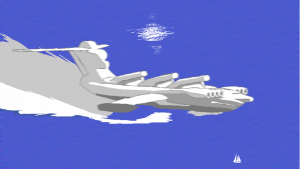TÉR-2500 (Pacifica)
 Modern artist's illustration of the TÉR-01-SP, the only unit produced of the TÉR-2500, flying past a sailboat
| |
| Class overview | |
|---|---|
| Name | TÉR-2500 |
| Builders | |
| Operators | Rhaynan Navy |
| In service |
|
| Planned | 1 |
| Building | 0 |
| Completed | 1 |
| Cancelled | 0 |
| Active | 1 |
| Laid up | 0 |
| Lost | 0 |
| Retired | 0 |
| Preserved | 0 |
| General characteristics | |
| Class and type | TÉR |
| Type | Attack/Transport (ground effect vehicle) |
| Displacement | Displacement n/a, weight 406.5 tonnes unloaded |
| Length | 104.9 metres (344 ft) |
| Beam | (Wing area) 883.1 square metres (9,506 sq ft) |
| Height | 27.3 metres (90 ft) |
| Draught | (2.5 metres or 8 feet 2 inches) |
| Propulsion | 8× Titos Kairelis MA-45 turbojet engines, 181.1 kN (40,700 lbf) thrust |
| Speed | 297 kn (550 km/h; 342 mph) |
| Range | 1,421.3 nmi (2,632.2 km; 1,635.6 mi) |
| Capacity | 140 tonnes |
| Complement | six officers and nine enlisted men |
| Armament |
|
The TÉR-2500 (Téras-2500) (Aegean: Τέρας-2500, literally "Monster" in aegean), known colloquially as the White Doom, it's the first ground effect vehicle developed by Rhayna in the 1960s by the Ekranoplan Design Bureau, The TÉR-2500 was tested weekly by the Rhaynan Navy in secrecy until 1976, when it was retired due to highly expensive maintenance routines and lack of situations where its intervention was necessary.
It flies using lift generated by the ground effect acting on its large wings when within about five meters (16.4 ft) above the surface of the water. Although they might look similar to traditional aircraft, ekranoplans like the TÉR-2500 are not classified as aircraft, seaplanes, hovercraft, or hydrofoils. Rather, crafts like the TÉR-2500 ekranoplan are classified as maritime ships by the International Maritime Organization due to their use of the ground effect, in which the craft glides just above the surface of the water.
The ground effect occurs when flying at an altitude of only a few meters above the ocean or ground; drag is greatly reduced by the proximity of the ground preventing the formation of wingtip vortices, thus increasing the efficiency of the wing. This effect does not occur at high altitude.
Design and developement
Current operators
Specifications
General characteristics
- Crew: 15 (6 officers, 9 enlisted)
- Capacity: 140 tonnes
- Length: 104.9 metres (344 ft)
- Wingspan: 77.2 metres (253 ft)
- Height: 27.3 metres (90 ft)
- Wing area: 883.1 square metres (9,506 sq ft)
- Empty weight: 406.5 tonnes
- Max takeoff weight: 546.5 tonnes
- Powerplant: 8 × Titos Kairelis MA-45 turbofans, 181.1 kN (40,700 lbf) thrust each
Performance
- Maximum speed: 550 km/h (340 mph; 300 kn)
- Cruise speed: 450 km/h (280 mph; 240 kn) at 3 metres (9.8 ft)
- Range: 2,632.2 km (1,635.6 mi; 1,421.3 nmi)
- Service ceiling: 5.3 metres (17 ft) in ground effect
Armament
- Guns: four 23 mm IT-10 turrets (2 x 2, 2,400 rounds)
- Missiles: six launchers for fixed-elevation A-210 Patrída antiship missiles